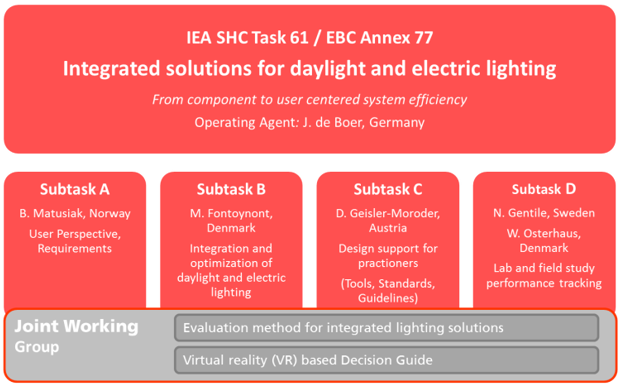To accomplish the objectives of the Task, the Participants carried out research and developments in the framework of the following four Subtasks and one joint working group:

Subtask A: User perspective and requirements
The newest research confirms long anticipated impact of lighting on people. Adequate lighting have positive impact on learning/work efficiency, mood and health. On the other side, people’s interaction with lighting systems have decisive impact on energy consumption for lighting. The human behaviour is nowadays the most important and challenging factor in lighting. This Subtask dealt with the consolidation of available knowledge (demands, chances and challenges) on user-, activity- and time-depending visual and non-visual requirements, as well as acceptance of lighting controls and their control strategies, including cultural and climatic dependencies. This knowledge was used to set up use cases in specific applications, reflecting typical temporal changes in the usage of these interior spaces. The usage and the corresponding lighting requirements were aggregated in so called personas, representations of the behaviour of a hypothesized group of users in the defined applications. Personas can be used to define the potential and benefits, such as user comfort and energy efficiency, of user centred integrated solutions more accurately, which is beneficial in the development (target group: lighting and façade industry) and lighting design (target groups: architects, lighting designers, policy makers and facility managers) of integrated solutions.
Subtask A project areas:
- A.1. User requirements
- A.2. Use cases
- A.3. Representation of user behaviour - personas
Subtask B: Integration and Optimization of Daylight and Electric Lighting
The Subtask's aim was to enlarge and communicate the potential and impact of integrated technical solutions with respect to user needs and system efficiency. Work focused especially on advanced light management concepts (e.g. contrast and DGP based, spectral controls, lighting load prediction, meteo prediction) on the link between user perspectives and technologies (sensors, electric lighting, façade). This was based on an appropriate modelling / performance metrics backbone. Workshops and projects with companies from different industrial sectors were held to combine knowledge and experience to allocate added value of integrated solutions.
The objective of this work was to identify the promising technical solutions to offer optimal control of lighting and daylighting components. The success of these solutions dealt with:
- minimum use of lighting electricity,
- maximum satisfaction of users, and
- most attractive user interface (for users and facility managers).
Subtask B project areas:
- B.1. Interview of professionals: opportunities and barriers
- B.2. Critical review of existing control systems and their functionalities
- B.3. Critical review of new approaches under development
- B.4. Review of other important aspects affecting performance of controls
- B.5. Critical analysis of interfaces
- B.6. Link with standardization activities
Subtask C: Design Support for Practitioners (Tools, Standards, Guidelines)
This Subtask focused on the application of technical innovations the field of integrated lighting solutions in practitioners’ workflows. The intent was to bring the findings onto the desktops of designers by integration of approaches into widely used software tools, standards and codes, and design guidelines.
An initial state-of-the-art review of workflows applied in current practice summarized well-working examples and highlighted open issues in the design of integrated lighting solutions. Existing approaches for the characterization of façade systems were collected and a compiled characterization scheme including specifications for measurements and simulations was proposed as a draft standard. For the design of integrated solutions that support human well-being not only intensities, but also spectral effects are important. To enable statements also for the daylight part of the integrated solution, a spectral sky model was elaborated. For the decision-making process, it is important to provide practitioners with a possibility to compare solutions. An hourly rating model for user-centered integral performance assessment was developed. This evaluation algorithm will allow for the assessment of both the non-visual effect and the energy efficiency of integrated lighting solutions at once.
Subtask C project areas:
- C.1. Review of state of the art design workflows
- C.2. Standardization of BSDF daylight system characterization
- C.3. Spectral sky models for advanced daylight simulations
- C.4. Hourly rating method for integrated solutions
Subtask D: Lab and Field Study Performance Tracking
This Subtask demonstrated and assessed, and either verify or reject, currently available and typically applied concepts for daylighting and electric lighting design and their integration in order to better understand how various integrated lighting systems and their control mechanisms behave with respect to a number of important parameters (e.g., energy use, thermal and visual environment, maintenance, adaptability to new requirements, etc.) and how building users respond to them. Work included a comprehensive literature review of relevant research materials (in close collaboration with Subtask A.1), targeted medium-term experiments in a number of living laboratories, supplemented by short-term investigations of specific concepts or ideas in controlled research laboratory environments, as well as performance tracking through “real” field studies in recently completed or retrofitted buildings across selected building types in several of the participating countries. Case studies were selected in close collaboration with other Subtasks, especially with subtasks A and B.
Subtask D project areas:
- D.1. Literature Survey: Quantifying Potential Energy Savings
- D.2. Monitoring Protocol
- D.3. Case Studies: Living Laboratories and Real Buildings
- D.4. Lessons Learned – Guidance to Decision Makers
Joint Working Group: Evaluation tool & VR Decision Guide
The targeted dissemination and communication of the Task's results need joint and collaborative efforts. All Subtasks provided major parts of their results, as input to the joint work group comprising the development of
- an evaluation method for integrated lighting solutions and
- a virtual reality (VR) decision guide.
Joint working group project areas:
- JWG.1. Evaluation method for integrated lighting solutions
- JWG.2. VR Decision Guide on integrated lighting solutions